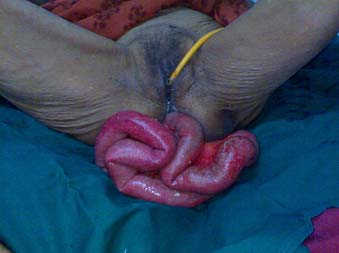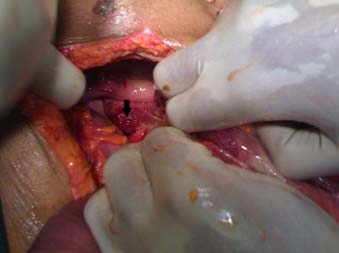Transanal Evisceration of Small Bowel-A Rare Surgical Emergency
Narayana Swamy Chetty Y.V.2, Sridhar M.1, Pankaja S.S.2
1 Assistant Professor, Department of Surgery, M.S.Ramaiah Medical College, Bangalore, India.
2 Associate Professor, Department of Surgery, M.S.Ramaiah Medical College, Bangalore, India.
3 Assistant Professor, Department of Surgery, M.S.Ramaiah Medical College, Bangalore, India.
NAME, ADDRESS, E-MAIL ID OF THE CORRESPONDING AUTHOR: Dr. Sridhar M., No. 181, 11th cross, 3rd main road, HIG colony, RMV 2nd stage, Bangalore-560094, India.
Phone: 9880190880,
E-mail: drsridharmuniyappa@yahoo.co.in
Transanal evisceration of small bowel is an extremely rare surgical emergency. This is the condition in which the small bowel herniates through breach in the anterior rectal wall and seen eviscerating through the anal canal. It is challenging for a surgeon to deal and manage such a case during emergency, especially if he hasn’t dealt with such condition earlier. The present case reported is of 68 year old lady referred to an institution with history of transanal herniation of small bowel for three days duration, following manual reduction of chronic rectal prolapse. The case report illustrates aetiology, management & factors influencing the outcome of this rare emergency have been discussed.
Case Report
A 68-year-old lady was referred to our emergency department, with evisceration of small bowel through anal canal following manual reduction of prolapsed rectum, three days ago. On careful and thorough examination, she was found to be hemodynamically stable. Abdomen was soft and did not show any features suggestive of peritonitis. About three feet of the small bowel with its mesentery was eviscerating through the anal canal which was congested, oedematous and had multiple serosal tears [Table/Fig-1].
Showing trans-anal evisceration of small bowel.

Showing rectal perforation

In emergency department, the eviscerated bowel was washed copiously with warm saline and covered with moist towels. Broad spectrum antibiotics were given and IV fluids were started. Relevant preoperative work up was done and patient was posted for emergency laparotomy.
A lower midline laparotomy was performed, and the eviscerated bowel was gently reduced into the peritoneal cavity with simultaneous support and guidance through the anal canal. After complete reduction of the eviscerated bowel into the peritoneal cavity, a 2x3 cms perforation was noted in the anterior wall of the middle third rectum [Table/Fig-2]. The margin of perforation was freshened and closed with interrupted polyglactin sutures. A sigmoid loop colostomy was also performed. In view of dilated and congested small bowel with multiple serosal tears, a laparostomy was performed to observe for the integrity and viability of bowel in post-operative period.
Immediate post-operative period was uneventful. After 48 hours, saline wash was given through the laparostoma, under epidural analgesia. The bowel appeared normal. However on the fourth post-operative day patient developed breathlessness, bradycardia, hypotension and desaturation with respiratory acidosis. On evaluation she was diagnosed to have acute myocardial infarction with elevated troponin-T levels. The patient was supported with ventilator and inotropes with immediate treatment of the acute myocardial infarction. Despite our prompt response and best supportive care, the patient did not recover from the cardiac insult and succumbed on the twelfth post operative day with multiple organ dysfunction.
Discussion
Transanal evisceration of bowel is a rare complication of chronic prolapse of rectum. This surgical emergency occurs due to herniation of bowel through the breech in the rectal wall. This condition was first described by Brodie in 1827, since then very few cases have been reported [1]. Wrobleski DE, Dailey TH presumed that mainly two factors predispose these patients for this unusual complication. More than 75% of these cases were associated with chronic prolapse of rectum and an event of sudden increase in intra-abdominal pressure [2—4]. Broden B, Snellman B with cine-radiographic studies tried to correlate prolapse rectum with perforation. The primary mechanism of rectal prolapse is a sliding hernia, in which the pouch of Douglas and contained viscera form the sac. The hernial sac invaginates the anterior wall of rectum into the rectal lumen resulting in ischemia and the weakening, making it more vulnerable for rectal perforation, allowing small bowel to herniate and eviscerate through the anal canal [5]. Hovey MA, Metcalf AM in 1997 and later Aron Trinidale et al., in 2010 have reported a similar cases of transanal evisceration of bowel following failed attempt of digital reduction of chronic rectal prolapse [3,6].
The other causes of transanal evisceration of bowel without pre-existing chronic rectal prolapse have been reported secondary to blunt injury abdomen, iatrogenic injuries or due to suction injuries mainly in the children [7,8].
The management of both types of transanal evisceration of bowel depends upon early and adequate resuscitative measures and a prompt surgical intervention. The surgical procedure performed depends upon the viability and contamination of the herniated bowel, associated co-morbidities and general condition of the patient [9].
Eviscerated bowel should be cleaned with normal saline and gently reduced into the peritoneal cavity with simultaneous support and guidance through the anal canal. However attempt to reduce the bowel through the anal canal without laparotomy is, most of the time, unsuccessful and results in higher mortality [10].
The gangrenous segment of the bowel should be resected and the rectal tear should be primarily repaired. The well thought judgement has to be taken for making proximal loop colostomy depending upon each case. The primary treatment for the cause of rectal prolapse like rectopexy, sigmoidectomy or hysterectomy when associated with uterine prolapse, could be considered to prevent recurrence [9].
Conclusion
Trans-anal evisceration of bowel is a rare complication of chronic rectal prolapse. Understanding the pathophysiology of rectal prolapse and transanal evisceration of bowel would help in efficient and prompt response in emergency setting, resulting in better recovery rates.
Majority of the patients with chronic rectal prolapse are elderly and associated with variety of co-morbidities. Hence, these patients should be encouraged to undergo early definitive surgery of rectal prolapse before such rare complications occur.
[1]. Brodie BC, A case of a singular variety of hernia treated at St. George’s Hospital London Medical and Physical Journal 1827 57:529-30. [Google Scholar]
[2]. Goligher JC, Injuries of the rectum and colon. In: Goligher JC, Duthie HL, Nixon H, editors Surgery of the anus rectum and colon 1984 5th EdLondonBailliereTindall:1133-34. [Google Scholar]
[3]. Hovey MA, Metcalf AM, Incarcerated rectal prolapse-rupture and Ileal evisceration after failed reduction Dis Colon Rectum 1997 40:1254-7. [Google Scholar]
[4]. Wrobleski DE, Dailey TH, Spontaneous rupture of the distal colon with evisceration of small intestine through the anus; report of two cases and review of literature Dis Colon Rectum 1979 22:569-72. [Google Scholar]
[5]. Broden B, Snellman B, Procidentia of rectum studied with cineradiography; a contribution of causative mechanism Dis Colon Rectum 1968 11:330-47. [Google Scholar]
[6]. Aron Trinidale, Muhammad Shakeel, Shahgehan Transanal small bowel evisceration following digital reduction of a chronically prolapsing rectum Journal of the college of Physicians and Surgeons Pakistan 2010 20(11):760-62. [Google Scholar]
[7]. Noushif Medapil, Blunt abdominal trauma with trans anal small bowel evisceration Journal of Emergencies,Trauma, and Shock 2013 6(1):56-57. [Google Scholar]
[8]. Price Neil R, Swimming pool filter-induced transrectal evisceration in children: Australian experience Med J Aust 2010 192(9):534-36. [Google Scholar]
[9]. Joon Joeng, Rupture of recto sigmoid colon with evisceration of the small bowel through anus Yonesi Medical Journal 2000 41(2):289-92. [Google Scholar]
[10]. Berwin JT, Ho TK, D’Souza R, Small Bowel Evisceration through the anus- report of a case and review of literature BMJ Case Reports 2012; doi; 10. 1136/bcr.12.2011.5316 [Google Scholar]